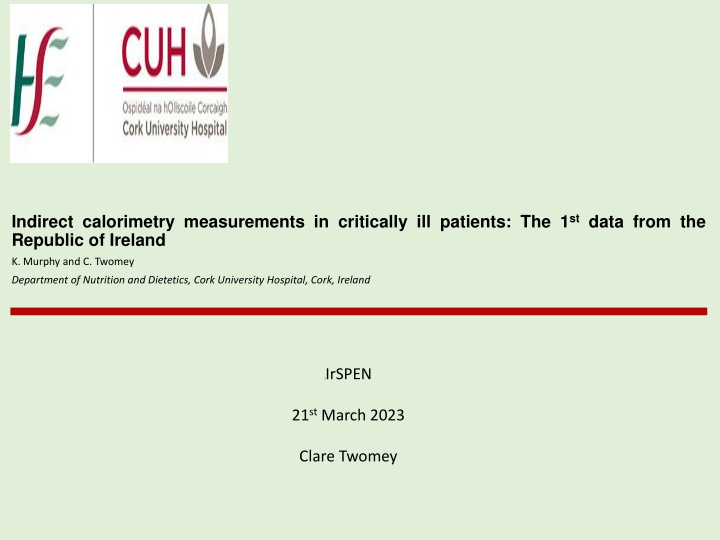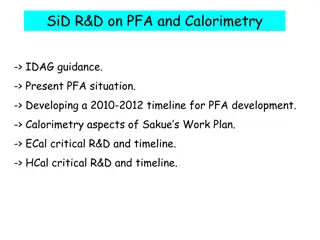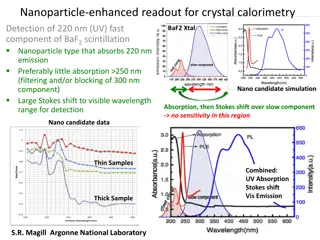Indirect Calorimetry Measurements in Critically Ill Patients: Insights from Ireland
This research by K. Murphy and C. Twomey of Cork University Hospital explores indirect calorimetry measurements in critically ill patients in Ireland. The study, presented at IrSPEN on 21st March 2023, offers valuable data and insights into the subject.
Download Presentation

Please find below an Image/Link to download the presentation.
The content on the website is provided AS IS for your information and personal use only. It may not be sold, licensed, or shared on other websites without obtaining consent from the author.If you encounter any issues during the download, it is possible that the publisher has removed the file from their server.
You are allowed to download the files provided on this website for personal or commercial use, subject to the condition that they are used lawfully. All files are the property of their respective owners.
The content on the website is provided AS IS for your information and personal use only. It may not be sold, licensed, or shared on other websites without obtaining consent from the author.
E N D
Presentation Transcript
Indirect calorimetry measurements in critically ill patients: The 1st data from the Republic of Ireland K. Murphy and C. Twomey Department of Nutrition and Dietetics, Cork University Hospital, Cork, Ireland IIrSPEN 21st March 2023 Clare Twomey
Introduction Adequate nutritional support in the critically ill, ICU patient has been shown to improve patient outcomes. It is well recognised that both over and under nutrition can negatively affect patient outcomes1. Historically nutritional requirements are calculated by the dietitian using equations to estimate resting energy expenditure alongside clinical judgement. Within the ICU setting many factors can affect resting energy expenditure and it is now recognised that the Gold Standard for assessing resting energy expenditure is indirect calorimetry (IC) 2. Cork University Hospital is the 1st hospital in the ROI to get an indirect calorimeter.
Methods IC data were collected on all patients that met the inclusion criteria admitted to a critical care unit in the Republic of Ireland during a 3 month period in 2022. Measurements were taken as close as possible to day 3, 5 and 7 of ICU admission and then weekly if patients remained ventilated within the ICU. Measurements were repeated if there was a significant change in clinical status.
Results 66 individual IC measurements were taken from 27 critically ill, ventilated patients (n = 27, 63% male, 37% female, mean BMI 27.5kg/m2) Indirect Calorimetry vs Penn State University Equation IC PSU 3000 2800 2600 2400 kcal 2200 2000 1800 1600 1400 1200 1000 3-4 5-6 7-13 14-20 21-27 28-34 35-41 42-48 Day
Results 66 individual IC measurements were taken from 27 critically ill, ventilated patients (n = 27, 63% male, 37% female, mean BMI 27.5kg/m2) Average Day IC kcal IC PSU kcal PSU kcal/kg kcal % kcal received kcal/kg received 3-4 (n=18) 2160 28 1894 25 1528 76 5-6 (n=9) 2212 30 1867 26 1866 87 7-13 (n=17) 2195 27 1944 24 2035 92 14-20 (n=10) 2307 25 2203 24 2368 108 21-27 (n=6) 2115 24 2153 24 2379 114 1859 25 2019 27 2256 123 28-34 (n=2) 35-41 (n=3) 1837 32 1728 29 2107 113 42-48 (n=1) 2345 39 1779 30 2804 120
Conclusion IC results were higher than expected in the acute phase of critical illness (27-30kcal/kg). IC results were lower than expected for days 14-27 (24-25kcal/kg). IC results were higher than the PSU equation for all stages of critical illness bar days 21- 34 of illness. Applying best practice guidelines (aiming for below 70% estimated needs) 2 may have resulted in under feeding in the acute phase of critical illness. These results further highlight the importance of individualised nutritional care for critically ill patients.
References 1. Heyland D K, Cahill N, Day A G. Optimal amount of calories for critically ill patients: depends on how you slice the cake! Crit Care Med 2011; 39: 2619-2626 2. Singer P, Blaser A R, Berger M M et al. ESPEN Guideline on clinical nutrition in the intensive care unit Clin Nut 2019; 38: 48-79























